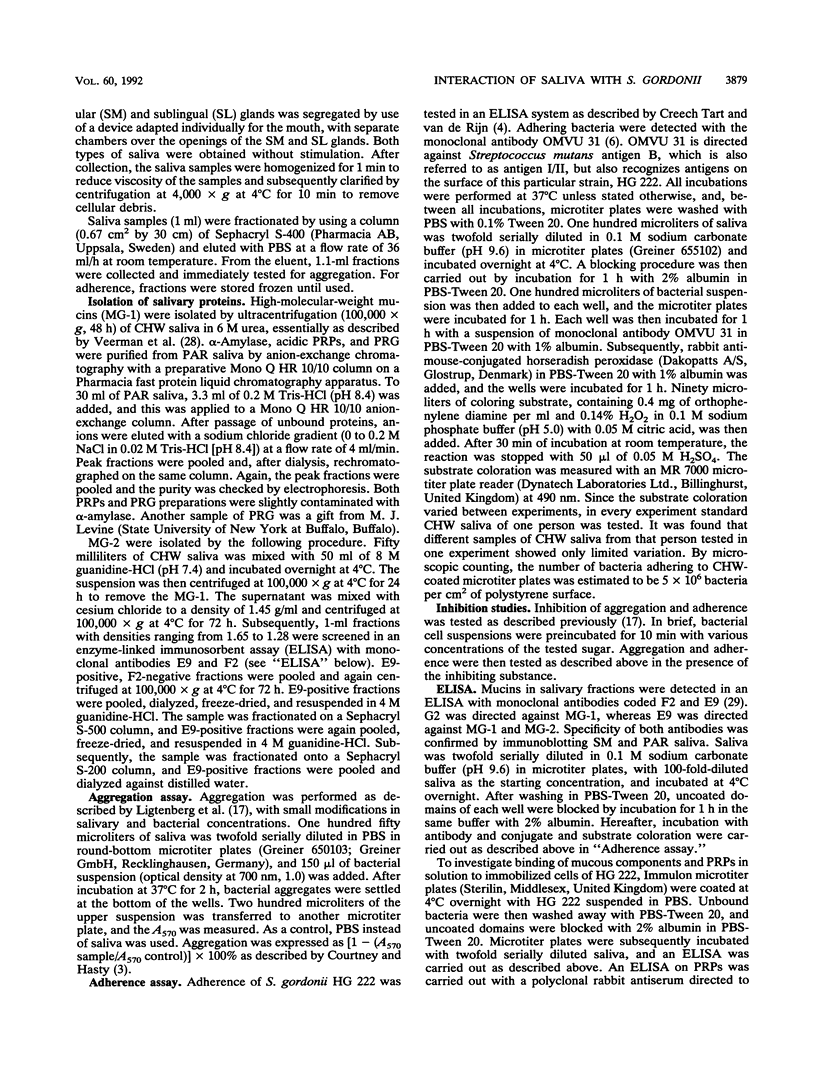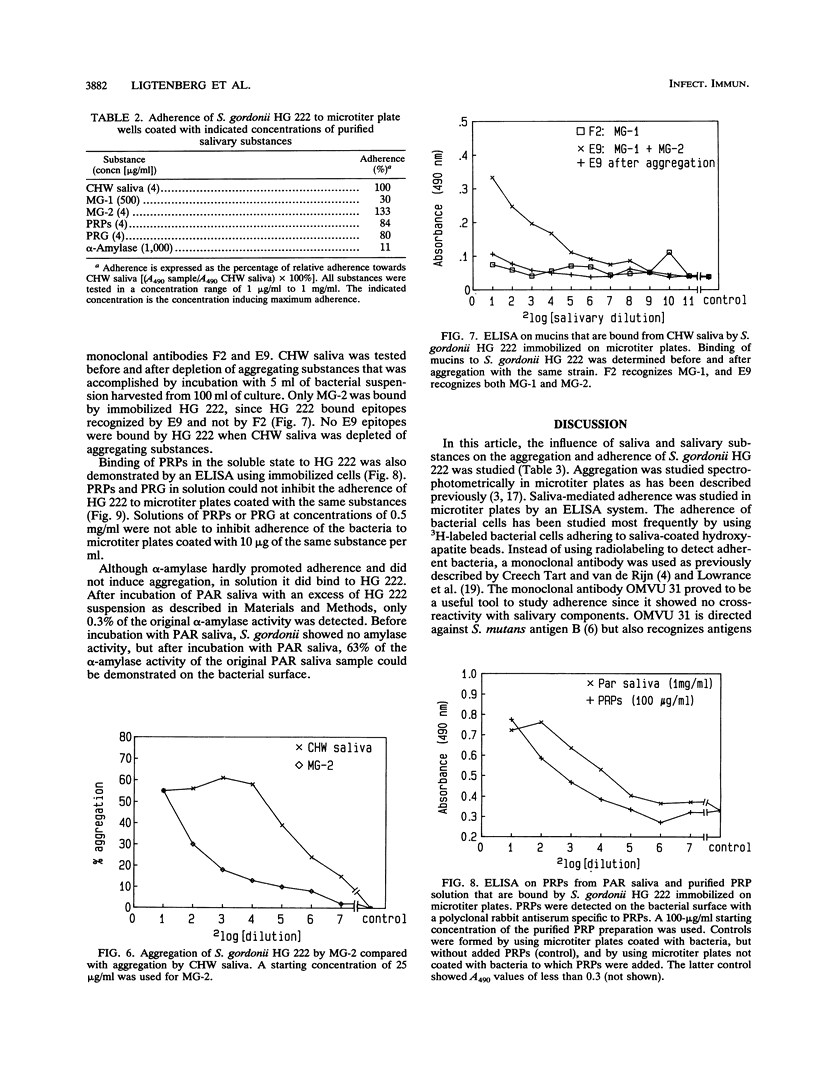Abstract
The influence of saliva on the aggregation and adherence of Streptococcus gordonii HG 222 was studied. The aggregation was measured spectrophotometrically, and the adherence of S. gordonii to microtiter plate wells was measured in an enzyme-linked immunosorbent assay system. The aggregation of HG 222 was induced primarily by mucous saliva, whereas the adherence of HG 222 to microtiter plates was mediated by both mucous and serous saliva. Fractions of submandibular saliva, obtained by gel filtration and containing low-molecular-weight mucins (MG-2), induced both bacterial aggregation and adherence. Purified MG-2 induced aggregation and promoted adherence, whereas high-molecular-weight mucins (MG-1) did not. After incubating clarified human whole saliva with HG 222, only MG-2, and not MG-1, was bound by the bacteria. Proline-rich proteins (PRPs) and proline-rich glycoprotein (PRG) promoted the adherence of HG 222. These proteins in solution bound to HG 222 but did not induce aggregation of the bacterial cells. PRPs and PRG in solution were not able to inhibit adherence to microtiter plate wells coated with the same components. Purified alpha-amylase hardly promoted adherence to microtiter plates but, in the soluble state, readily bound to HG 222. In conclusion, these results indicate that the aggregation of S. gordonii HG 222 is mediated primarily by MG-2. These mucins also promote adherence. Several other salivary components, such as PRPs and PRG, are also involved in the adherence of HG 222.
Full text
PDF






Selected References
These references are in PubMed. This may not be the complete list of references from this article.
- Bergey E. J., Levine M. J., Reddy M. S., Bradway S. D., Al-Hashimi I. Use of the photoaffinity cross-linking agent N-hydroxysuccinimidyl-4-azidosalicylic acid to characterize salivary-glycoprotein-bacterial interactions. Biochem J. 1986 Feb 15;234(1):43–48. doi: 10.1042/bj2340043. [DOI] [PMC free article] [PubMed] [Google Scholar]
- Biesbrock A. R., Reddy M. S., Levine M. J. Interaction of a salivary mucin-secretory immunoglobulin A complex with mucosal pathogens. Infect Immun. 1991 Oct;59(10):3492–3497. doi: 10.1128/iai.59.10.3492-3497.1991. [DOI] [PMC free article] [PubMed] [Google Scholar]
- Courtney H. S., Hasty D. L. Aggregation of group A streptococci by human saliva and effect of saliva on streptococcal adherence to host cells. Infect Immun. 1991 May;59(5):1661–1666. doi: 10.1128/iai.59.5.1661-1666.1991. [DOI] [PMC free article] [PubMed] [Google Scholar]
- Degand P., Aubert J. P., Boersma A., Richet C., Loucheux-Lefebvre M. H., Biserte G. Parotid alpha-amilase activity: a possible role for proline-rich proteins. FEBS Lett. 1976 Mar 15;63(1):137–140. doi: 10.1016/0014-5793(76)80211-6. [DOI] [PubMed] [Google Scholar]
- Douglas C. W. Characterization of the alpha-amylase receptor of Streptococcus gordonii NCTC 7868. J Dent Res. 1990 Nov;69(11):1746–1752. doi: 10.1177/00220345900690110701. [DOI] [PubMed] [Google Scholar]
- Gibbons R. J., Hay D. I. Human salivary acidic proline-rich proteins and statherin promote the attachment of Actinomyces viscosus LY7 to apatitic surfaces. Infect Immun. 1988 Feb;56(2):439–445. doi: 10.1128/iai.56.2.439-445.1988. [DOI] [PMC free article] [PubMed] [Google Scholar]
- Gibbons R. J., Hay D. I., Schlesinger D. H. Delineation of a segment of adsorbed salivary acidic proline-rich proteins which promotes adhesion of Streptococcus gordonii to apatitic surfaces. Infect Immun. 1991 Sep;59(9):2948–2954. doi: 10.1128/iai.59.9.2948-2954.1991. [DOI] [PMC free article] [PubMed] [Google Scholar]
- Hogg S. D., Embery G. Blood-group-reactive glycoprotein from human saliva interacts with lipoteichoic acid on the surface of Streptococcus sanguis cells. Arch Oral Biol. 1982;27(3):261–268. doi: 10.1016/0003-9969(82)90060-7. [DOI] [PubMed] [Google Scholar]
- Hogg S. D., Embery G. The isolation and partial characterization of a sulphated glycoprotein from human whole saliva which aggregates strains of Streptococcus sanguis but not Streptococcus mutans. Arch Oral Biol. 1979;24(10-11):791–797. doi: 10.1016/0003-9969(79)90040-2. [DOI] [PubMed] [Google Scholar]
- Koop H. M., Valentijn-Benz M., Nieuw Amerongen A. V., Roukema P. A., de Graaff J. Aggregation of oral bacteria by human salivary mucins in comparison to salivary and gastric mucins of animal origin. Antonie Van Leeuwenhoek. 1990 Nov;58(4):255–263. doi: 10.1007/BF00399337. [DOI] [PubMed] [Google Scholar]
- Koop H. M., Valentijn-Benz M., Nieuw Amerongen A. V., Roukema P. A., de Graaff J. Involvement of human mucous saliva and salivary mucins in the aggregation of the oral bacteria Streptococcus sanguis, Streptococcus oralis, and Streptococcus rattus. Antonie Van Leeuwenhoek. 1990 May;57(4):245–252. doi: 10.1007/BF00400156. [DOI] [PubMed] [Google Scholar]
- Levine M. J., Reddy M. S., Tabak L. A., Loomis R. E., Bergey E. J., Jones P. C., Cohen R. E., Stinson M. W., Al-Hashimi I. Structural aspects of salivary glycoproteins. J Dent Res. 1987 Feb;66(2):436–441. doi: 10.1177/00220345870660020901. [DOI] [PubMed] [Google Scholar]
- Ligtenberg A. J., Veerman E. C., de Graaff J., Nieuw Amerongen A. V. Influence of the blood group reactive substances in saliva on the aggregation of Streptococcus rattus. Antonie Van Leeuwenhoek. 1990 Feb;57(2):97–107. doi: 10.1007/BF00403161. [DOI] [PubMed] [Google Scholar]
- Ligtenberg A. J., Veerman E. C., de Graaff J., Nieuw Amerongen A. V. Saliva-induced aggregation of oral streptococci and the influence of blood group reactive substances. Arch Oral Biol. 1990;35 (Suppl):141S–143S. doi: 10.1016/0003-9969(90)90145-z. [DOI] [PubMed] [Google Scholar]
- Lowrance J. H., Hasty D. L., Simpson W. A. Adherence of Streptococcus sanguis to conformationally specific determinants in fibronectin. Infect Immun. 1988 Sep;56(9):2279–2285. doi: 10.1128/iai.56.9.2279-2285.1988. [DOI] [PMC free article] [PubMed] [Google Scholar]
- Orstavik D., Kraus F. W., Henshaw L. C. In vitro attachment of streptococci to the tooth surface. Infect Immun. 1974 May;9(5):794–800. doi: 10.1128/iai.9.5.794-800.1974. [DOI] [PMC free article] [PubMed] [Google Scholar]
- Rosan B., Malamud D., Appelbaum B., Golub E. Characteristic differences between saliva-dependent aggregation and adhesion of streptococci. Infect Immun. 1982 Jan;35(1):86–90. doi: 10.1128/iai.35.1.86-90.1982. [DOI] [PMC free article] [PubMed] [Google Scholar]
- Rundegren J. Calcium-dependent salivary agglutinin with reactivity to various oral bacterial species. Infect Immun. 1986 Jul;53(1):173–178. doi: 10.1128/iai.53.1.173-178.1986. [DOI] [PMC free article] [PubMed] [Google Scholar]
- Scannapieco F. A., Bergey E. J., Reddy M. S., Levine M. J. Characterization of salivary alpha-amylase binding to Streptococcus sanguis. Infect Immun. 1989 Sep;57(9):2853–2863. doi: 10.1128/iai.57.9.2853-2863.1989. [DOI] [PMC free article] [PubMed] [Google Scholar]
- Scannapieco F. A., Bhandary K., Ramasubbu N., Levine M. J. Structural relationship between the enzymatic and streptococcal binding sites of human salivary alpha-amylase. Biochem Biophys Res Commun. 1990 Dec 31;173(3):1109–1115. doi: 10.1016/s0006-291x(05)80900-3. [DOI] [PubMed] [Google Scholar]
- Shibata S., Nagata K., Nakamura R., Tsunemitsu A., Misaki A. Interaction of parotid saliva basic glycoprotein with Streptococcus sanguis ATCC 10557. J Periodontol. 1980 Sep;51(9):499–504. doi: 10.1902/jop.1980.51.9.499. [DOI] [PubMed] [Google Scholar]
- Stinson M. W., Levine M. J., Cavese J. M., Prakobphol A., Murray P. A., Tabak L. A., Reddy M. S. Adherence of Streptococcus sanguis to salivary mucin bound to glass. J Dent Res. 1982 Dec;61(12):1390–1393. doi: 10.1177/00220345820610120101. [DOI] [PubMed] [Google Scholar]
- Tart R. C., van de Rijn I. Analysis of adherence of Streptococcus defectivus and endocarditis-associated streptococci to extracellular matrix. Infect Immun. 1991 Mar;59(3):857–862. doi: 10.1128/iai.59.3.857-862.1991. [DOI] [PMC free article] [PubMed] [Google Scholar]
- Veerman E. C., Valentijn-Benz M., Bank R. A., Nieuw Amerongen A. V. Isolation of high molecular weight mucins from human whole saliva by ultracentrifugation. J Biol Buccale. 1989 Dec;17(4):307–312. [PubMed] [Google Scholar]
- Veerman E. C., Valentijn-Benz M., van den Keybus P. A., Rathman W. M., Sheehan J. K., Nieuw Amerongen A. V. Immunochemical analysis of high molecular-weight human salivary mucins (MG1) using monoclonal antibodies. Arch Oral Biol. 1991;36(12):923–932. doi: 10.1016/0003-9969(91)90125-e. [DOI] [PubMed] [Google Scholar]
- Williams R. C., Gibbons R. J. Inhibition of streptococcal attachment to receptors on human buccal epithelial cells by antigenically similar salivary glycoproteins. Infect Immun. 1975 Apr;11(4):711–718. doi: 10.1128/iai.11.4.711-718.1975. [DOI] [PMC free article] [PubMed] [Google Scholar]
- Wyatt J. E., Willcox M. D., Russell R. R., Handley P. S. Fibrillar strains of Streptococcus sanguis biotype I carry a surface protein which cross-reacts with Antigen B from Streptococcus mutans Ingbritt. Oral Microbiol Immunol. 1988 Dec;3(4):162–168. doi: 10.1111/j.1399-302x.1988.tb00003.x. [DOI] [PubMed] [Google Scholar]
- de Soet J. J., van Dalen P. J., Russell R. R., de Graaff J. Identification of mutans streptococci with monoclonal antibodies. Antonie Van Leeuwenhoek. 1990 Nov;58(4):219–225. doi: 10.1007/BF00399332. [DOI] [PubMed] [Google Scholar]


